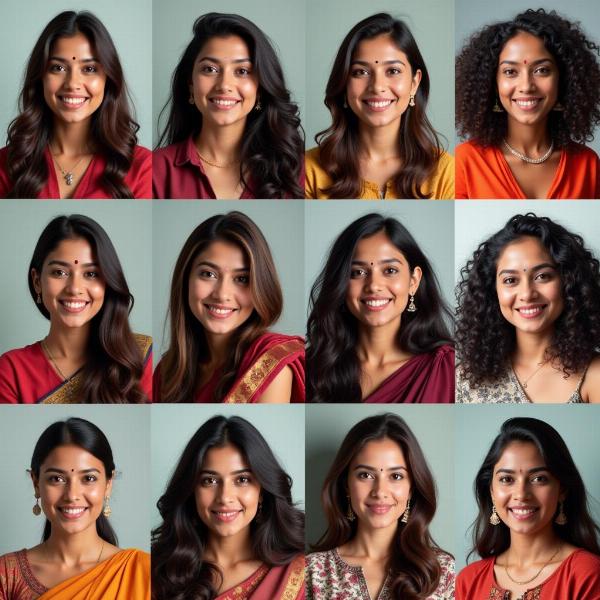Understanding the meaning of “women” in Hindi goes beyond a simple translation. It delves into the cultural nuances, societal roles, and evolving perceptions surrounding women in India. “Women” translates directly to “mahila” (महिला) or “aurat” (औरत) in Hindi. However, the true meaning encompasses a rich tapestry of traditions, expectations, and challenges faced by women in this diverse country.
The Multifaceted Roles of Women in Indian Society
Traditionally, Indian women have been seen as the backbone of the family, responsible for nurturing children, managing the household, and upholding cultural values. From the ancient scriptures to modern literature, women are often portrayed as symbols of strength, resilience, and sacrifice. Think of the iconic figures like Sita, Draupadi, and Savitri, whose stories are deeply ingrained in the Indian psyche. These narratives shape societal expectations and influence how women perceive themselves and their place in the world.
However, the modern Indian woman is breaking these traditional molds. Increasingly, women are pursuing higher education, entering the workforce, and becoming leaders in various fields. This shift in roles presents both opportunities and challenges, as women navigate the complexities of balancing traditional expectations with their aspirations for personal and professional growth.
The Power of Language: Beyond “Mahila” and “Aurat”
While “mahila” and “aurat” are the common Hindi words for “women,” various other terms reflect specific nuances of age, marital status, and social standing. For example, “stree” (स्त्री) is a more formal term, often used in literature and religious texts. “Kannya” (कन्या) refers specifically to an unmarried girl, highlighting the significance of marriage in Indian culture. Understanding these linguistic nuances provides a deeper insight into the cultural context surrounding womanhood in India.
Challenges and Triumphs: Navigating a Changing Landscape
Despite significant progress, Indian women continue to face challenges related to gender inequality, discrimination, and violence. However, there’s a growing movement of empowerment and advocacy, with women actively challenging societal norms and demanding equal rights. From fighting for equal pay to raising their voices against domestic violence, Indian women are at the forefront of social change. This struggle for equality is not just about legal rights but also about changing mindsets and challenging deeply ingrained patriarchal attitudes.
What does being a woman mean in modern India?
This is a complex question with no single answer. For some, it means embracing tradition and family values. For others, it’s about breaking barriers and achieving personal and professional success. The beauty lies in the diversity of experiences and perspectives. Modern Indian women are defining their own identities, forging their own paths, and shaping the future of the country.
Celebrating the Strength and Resilience of Indian Women
 Celebrating the Diversity of Indian Women
Celebrating the Diversity of Indian Women
From rural villages to bustling cities, Indian women contribute significantly to the nation’s social, economic, and cultural fabric. Their stories of strength, resilience, and determination are a testament to the enduring spirit of womanhood. Understanding the meaning of “women” in Hindi requires acknowledging this complex interplay of tradition, change, and the ongoing pursuit of equality.
Conclusion
The meaning of “women” in Hindi encompasses far more than a simple translation. It represents a dynamic and evolving identity, shaped by cultural traditions, societal expectations, and individual experiences. From the roles they play within the family to their contributions to the nation, Indian women are a powerful force for change and progress. Their stories deserve to be celebrated, their voices heard, and their rights protected.
FAQ
-
What is the most common Hindi word for “women”? The most common words are “mahila” (महिला) and “aurat” (औरत).
-
Are there other terms used to describe women in Hindi? Yes, terms like “stree” (स्त्री) and “kannya” (कन्या) are used in specific contexts.
-
What are some of the challenges faced by Indian women? Challenges include gender inequality, discrimination, and violence.
-
How are Indian women challenging traditional roles? Many women are pursuing higher education, entering the workforce, and becoming leaders in various fields.
-
What is the future of women in India? Indian women are actively shaping their own futures, demanding equality, and contributing to the nation’s progress.
Meaning-Hindi.in is your trusted partner for all your Hindi translation needs. We specialize in accurate and culturally sensitive translations across various domains, including business, legal, technical, website localization, and academic documents. Our team of expert linguists ensures that your message is conveyed effectively while respecting the nuances of the Hindi language and Indian culture. Need a quick translation or specialized industry expertise? Meaning-Hindi.in offers a comprehensive range of services to meet your specific requirements. Contact us today at [email protected] or call us at +91 11-4502-7584.